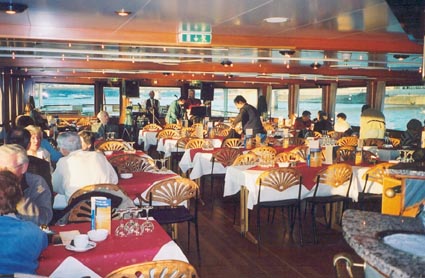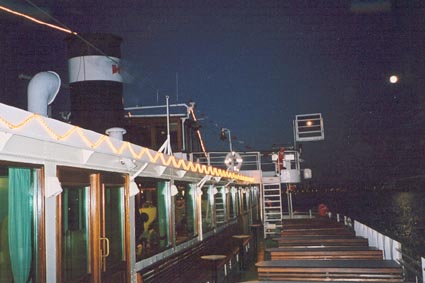
Pictured leaving Cologne on a Christmas Cruise in mid December 2002, the German paddle steamer Goethe was built in 1913 by Gebr Sachsenberg for the secondary Rhine steamer services. In 1925 she was given a major rebuild with enhanced accommodation for up to 2,400 passengers and, as a result, was upgraded to take her place on the primary Rhine services. In 1945 she was sunk by allied bombing but, fortunately, was raised, rebuilt and returned to service in 1953.
By the 1980s her condition was beginning to cause some concern and, after some mechanical problems, Goethe was withdrawn in 1989 leaving fears that she would follow so many of her predecessors into the scrapyard. In 1913 there had been more than thirty Rhine paddle steamers. By 1939 there were twenty. By 1970 there were six. By 1985 there were just three and only one of these, Goethe, was still operational .
However, against the odds, funds were found. Yet another rebuild was started and by the mid 1990s Goethe was back in service running on the scenic route between Rudesheim and Koblenz each summer and sailing from Cologne at various other times.

Goethe is 83m long (almost 10 m longer than the Scottish Waverley), has a beam of 15.7m and, in common with almost all continental paddle steamers, uses no winches forward or aft for manoeuvring on and off the piers . Here two crew members handle the ropes as a team of Santa’s Little Helpers scale the bridge wing to give the captain some handy tips on parking.
Goethe was built with two rudders fitted athwartships aft to aid manoeuvring in the very fast flowing Rhine currents and now has some high-tech modern equipment to assist her including both bow and stern thrusts for turning round short in confined waters thereby obviating the need to engage an expensive tug.


Like many of the Rhine steamers of the past, Goethe is almost wall to wall saloons with large picture windows to give good views of the passing scenery and plenty of tables and chairs to encourage passengers to sit down and buy something from the tempting menus to enhance their enjoyment of the trip.

The range and quality of food and drink is excellent catering for anything from a simple cup of tea with a delicious slice of cherry tarte mit plenty von frisches whipped Sahne on top, to a delicious four course meal.

Lovers of the Swiss paddle steamers will know that the one and only engine that the Gebr Sachsenberg built for a Swiss steamer, the Stadt Luzern in 1927, most embarrassingly failed on trials and was replaced by an engine from the Swiss manufacturer Sulzer. However, the two cylinder compound diagonal engine that Sachsenberg built for the Goethe in 1913 is still propelling the ship today.

Goethe is now twinned with the Swiss paddle steamer Schiller and, on the day that I was there, one of the Lake Lucerne paddle steamer engineers was in Cologne visiting Goethe’s engine room.

Looking aft at the paddle steamer wake, the saloon windows on two decks and the empties which very much help to finance the operation.

Fortunately the other two Rhine paddlers left in 1985 have also survived although they are not running on the Rhine. The Rheinland pictured in December 2001 as the Majesteit, was built in 1926 also by Gebr Sachsenburg and ran on the principal Rhine routes, from 1965 with the new name Rudesheim, until 1981 after which she was retained in reserve and as a pontoon at Cologne. The Key family of Holland bought her in 1993, set about a major rebuild and now re-named Majesteit, the Rudesheim, ex Rheinland is running from Rotterdam.

The third steamer left in 1985, Mainz, pictured at Mannheim in November 2002, was built in 1929 by Christof Ruthof and ran until 1980 when an engine failure caused her premature withdrawal. In 1986 she was towed to Mannheim for a new role as a static museum ship. With her original engines, boiler, galley and much else on view, Mainz uniquely retains something of the onboard period atmosphere of a Rhine paddle steamer of yesteryear.

It is true that Goethe does have rather a modern feel about her. But she is still a paddle steamer. She is still propelled by her 1913 steam engine. She has survived being bombed. She has been rebuilt four times. And she is the last and only paddle steamer steamer operating on the scenic Rhine today.
For investing in her and keeping her sailing into the twenty first century in such good condition, her owners, the KD, are to be very much congratulated. And with Ryanair, Buzz, German Wings and Hapag-Lloyd Express all flying to Germany at such incredibly low fares, never has a trip to experience the delights of a Rhine paddle steamer been so affordable!
Kingswear Castle returned to service in 2023 after the first part of a major rebuild which is designed to set her up for the next 25 years running on the River Dart. The Paddle Steamer Kingswear Castle Trust is now fund raising for the second phase of the rebuild. You can read more about the rebuilds and how you can help if you can here.
John Megoran


